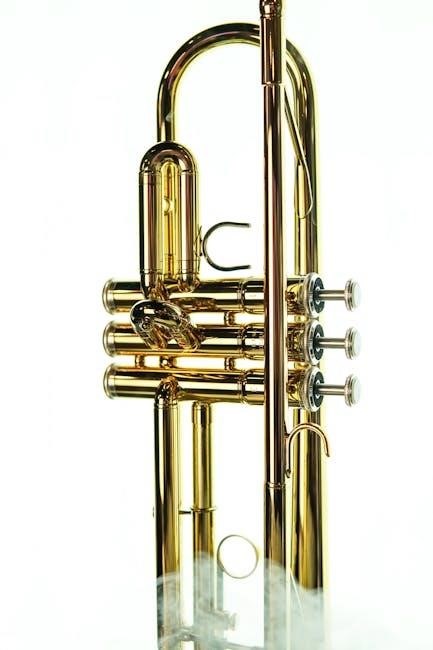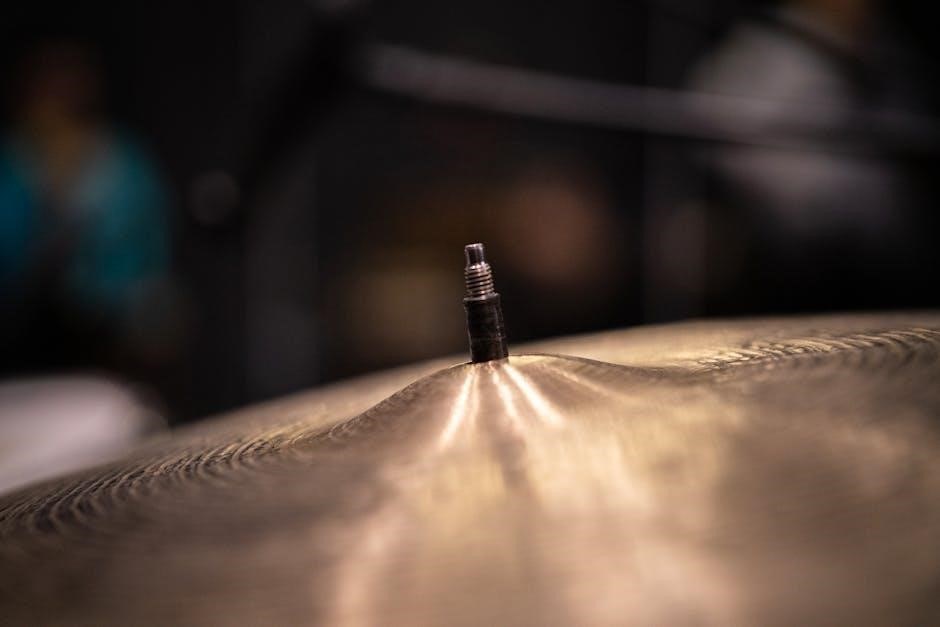SPI‚ or Serial Peripheral Interface‚ is a synchronous serial communication protocol developed by Motorola in the 1980s. It enables high-speed‚ short-distance data transfer between microcontrollers and peripherals‚ widely used in embedded systems and music technology applications.
1.1 What is SPI?
SPI‚ or Serial Peripheral Interface‚ is a synchronous serial communication protocol enabling high-speed‚ short-distance data transfer between microcontrollers and peripheral devices. Developed by Motorola in the 1980s‚ SPI is a four-wire interface using MISO (Master In‚ Slave Out)‚ MOSI (Master Out‚ Slave In)‚ SCK (Clock)‚ and SS (Slave Select) lines. It facilitates reliable communication with sensors‚ ADCs‚ DACs‚ and other ICs‚ making it a cornerstone in embedded systems and music technology applications. Its simplicity‚ efficiency‚ and versatility have solidified SPI as a standard for connecting peripherals‚ ensuring seamless integration in modern electronic designs and music production equipment.
1.2 History and Development of SPI
SPI‚ or Serial Peripheral Interface‚ was developed by Motorola in the 1980s as a standard interface for connecting peripherals in embedded systems. Initially designed for short-distance‚ high-speed communication‚ SPI quickly became a widely adopted protocol due to its simplicity and efficiency. Over the years‚ it has evolved to support various applications‚ including music technology‚ where it enables seamless integration of audio interfaces‚ MIDI controllers‚ and DSP systems. Its versatility and reliability have made SPI a cornerstone in modern electronics‚ driving innovation in both industrial and creative fields‚ including music production and performance equipment.
1.3 Importance of SPI in Modern Electronics
SPI is a cornerstone in modern electronics‚ enabling efficient communication between microcontrollers and peripherals. Its synchronous serial interface ensures high-speed‚ reliable data transfer‚ critical for real-time applications. In music technology‚ SPI facilitates seamless integration of audio interfaces‚ MIDI controllers‚ and DSP systems‚ enhancing performance and production. Its versatility supports various peripherals‚ from sensors to memory devices‚ making it indispensable in embedded systems. SPI’s simplicity and efficiency drive innovation across industries‚ ensuring it remains a vital protocol for connecting and controlling devices in both industrial and creative applications.
SPI Basics and Terminology
SPI is a four-wire interface with Master-In-Slave-Out (MISO)‚ Master-Out-Slave-In (MOSI)‚ Clock (SCK)‚ and Chip Select (CS) lines‚ enabling high-speed communication in music tech applications.
2.1 Key Components of SPI Communication
The SPI communication system relies on four primary wires: Master-In-Slave-Out (MISO)‚ Master-Out-Slave-In (MOSI)‚ Clock (SCK)‚ and Chip Select (CS). These components enable synchronized data transfer between devices. The MISO line carries data from the slave to the master‚ while MOSI sends data from the master to the slave. The SCK line provides the clock signal‚ dictating the data transfer rate. The CS line selects the specific slave device‚ ensuring data is sent to the correct peripheral. Together‚ these components form the foundation of SPI communication‚ allowing efficient and reliable data exchange in music technology applications.
2.2 Master-Slave Architecture in SPI
SPI operates using a master-slave architecture‚ where one device acts as the master and others as slaves. The master generates the clock signal (SCK) and initiates communication‚ while slaves respond to the master’s requests. Data transfer is synchronized with the clock‚ ensuring precise timing. This architecture allows for efficient communication‚ with the master controlling multiple slaves by selecting them via the Chip Select (CS) line. In music technology‚ this setup enables seamless integration of peripherals like audio interfaces and MIDI controllers‚ ensuring synchronized data flow and reliable performance in embedded systems and musical applications.
2.3 Clock Speed and Data Transfer Rates
Clock speed and data transfer rates are critical in SPI communication‚ determining how quickly data is transmitted. The clock signal (SCK) is generated by the master device‚ with speeds varying from a few kHz to tens of MHz. Higher clock speeds enable faster data transfer‚ essential for real-time applications like audio processing. In music technology‚ SPI’s high-speed capability ensures low latency and precise timing‚ crucial for synchronizing audio interfaces‚ synthesizers‚ and effects processors. The protocol’s flexibility allows adjusting clock speeds to suit specific requirements‚ optimizing performance for diverse musical applications while maintaining reliable data throughput.

SPI in Embedded Systems
SPI is a cornerstone in embedded systems‚ enabling efficient communication between microcontrollers and peripherals like sensors‚ ADCs‚ and DACs. Its simplicity and versatility make it indispensable for integrating diverse components seamlessly.
3.1 Role of SPI in Microcontroller Applications
SPI plays a vital role in microcontroller applications‚ enabling efficient communication with peripherals like sensors‚ audio interfaces‚ and MIDI controllers. Its high-speed‚ synchronous data transfer ensures precise timing‚ crucial for real-time music processing. By connecting microcontrollers to devices such as ADCs and DACs‚ SPI facilitates seamless integration of audio signals‚ making it indispensable in music technology. This protocol’s simplicity and reliability allow developers to focus on creating innovative musical applications‚ from effects processors to live performance systems‚ ensuring optimal performance and synchronization in modern music production environments.
3.2 Common Peripherals Connected via SPI
In music technology‚ SPI commonly connects microcontrollers to peripherals like audio codecs‚ MIDI controllers‚ and synthesizers. These peripherals enable precise control over musical data‚ ensuring synchronization and high-quality sound reproduction. SPI’s efficiency in handling audio signals makes it ideal for integrating sensors‚ ADCs‚ and DACs‚ which are crucial for processing and converting analog audio inputs to digital formats; This connectivity allows for seamless communication between devices‚ facilitating real-time processing and enhancing the overall music production experience. SPI’s versatility ensures reliable performance across various musical applications‚ from live performances to studio recordings.
3.3 Advantages of SPI Over Other Interfaces
SPI offers several advantages over other interfaces‚ particularly in music technology. Its full-duplex communication allows simultaneous data transmission and reception‚ enhancing real-time processing capabilities. SPI’s high-speed data transfer rates ensure minimal latency‚ crucial for audio applications. Unlike I2C or UART‚ SPI uses a dedicated clock line‚ providing better synchronization and reducing errors. Its simplicity and low power consumption make it ideal for embedded systems. Additionally‚ SPI’s flexibility supports various peripherals‚ from sensors to synthesizers‚ making it a versatile choice for both live performances and studio recordings. These features ensure SPI remains a preferred interface in modern music technology.
SPI Applications in Music Technology
SPI is widely used in music technology for audio interfaces‚ MIDI controllers‚ and digital signal processing. Its high-speed communication enables seamless integration of synthesizers and effects processors‚ enhancing musical performances and productions.
4.1 SPI in Audio Interfaces and Sound Cards
SPI plays a crucial role in audio interfaces and sound cards‚ enabling high-speed communication between microcontrollers and digital signal processors. Its synchronous nature ensures low-latency data transfer‚ essential for real-time audio processing. SPI facilitates the integration of analog-to-digital converters (ADCs) and digital-to-analog converters (DACs)‚ which are vital for converting audio signals. This protocol supports the seamless operation of effects processors‚ ensuring high-quality sound reproduction. By streamlining data transmission‚ SPI enhances the performance of audio interfaces‚ making it a cornerstone in modern music technology and professional sound systems.

4.2 SPI-Enabled MIDI Controllers and Synthesizers
SPI enhances MIDI controllers and synthesizers by enabling efficient communication between microcontrollers and peripheral devices. It facilitates the transfer of MIDI data‚ such as notes‚ velocities‚ and control signals‚ with high precision. SPI’s high-speed data transfer ensures real-time processing‚ crucial for live performances and dynamic sound generation. This protocol integrates seamlessly with sensors and actuators‚ allowing MIDI controllers to respond instantly to user inputs. Additionally‚ SPI supports the operation of effects processors‚ enabling the creation of complex sounds and textures. Its reliability and efficiency make it a vital component in modern music production and performance equipment.
4.3 SPI in Digital Signal Processing (DSP)
SPI plays a crucial role in Digital Signal Processing (DSP) by enabling high-speed‚ synchronous communication between DSP processors and peripheral devices. This protocol ensures efficient data transfer‚ which is essential for real-time audio processing tasks such as effects generation‚ filtering‚ and sound synthesis. SPI’s ability to handle high data rates allows for precise control over DSP operations‚ making it ideal for applications like reverb‚ delay‚ and equalization. Its reliability and low latency ensure accurate signal processing‚ which is critical in professional audio systems. SPI’s integration with DSP hardware enhances overall system performance‚ delivering high-quality audio outputs for music production and live performances.
Setting Up an SPI Network
Setting up an SPI network involves configuring hardware with a four-wire interface (MOSI‚ MISO‚ SCK‚ CS) and ensuring proper software configuration for master-slave communication and data transfer.
5.1 Hardware Requirements for SPI Communication
Setting up an SPI network requires a four-wire interface: Master Out Slave In (MOSI)‚ Master In Slave Out (MISO)‚ Serial Clock (SCK)‚ and Chip Select (CS). These wires connect a master device‚ typically a microcontroller‚ to one or more slave devices‚ such as sensors or peripherals. Additional hardware includes logic level shifters for voltage compatibility and pull-up resistors for signal integrity. The microcontroller must support SPI protocol‚ and peripheral devices must be compatible with the same voltage and clock speed. Proper grounding and power supply connections are essential for reliable communication. This setup is widely used in music technology for syncing audio interfaces and MIDI controllers.
5.2 Software Configuration for SPI
Software configuration for SPI involves initializing the protocol in the microcontroller. This includes setting the SPI mode (Mode 0 to Mode 3) and clock speed. Pins are configured as master or slave‚ and the SPI peripheral is enabled. Data transmission is managed by sending and receiving bytes through MOSI and MISO. Interrupts can be used for efficient communication. In music applications‚ SPI software ensures real-time data transfer between audio interfaces and MIDI controllers. Proper configuration is critical for synchronization and performance‚ making it a cornerstone of modern music technology integration with embedded systems.
5.3 Best Practices for SPI Implementation
Best practices for SPI implementation involve proper hardware setup and software configuration. Use appropriate termination resistors to minimize signal reflections. Ensure clock speeds match peripheral capabilities to avoid data loss. Shield wires to reduce noise interference. Implement error handling and synchronization mechanisms for reliable communication. Regularly test SPI connections to ensure stability. In music applications‚ optimize SPI for low latency and high throughput to maintain audio quality. Follow protocol standards to ensure compatibility across devices. Proper grounding and signal routing are essential for noise-free operation. These practices ensure efficient and reliable SPI communication in embedded systems and music technology applications.

SPI Protocols and Variants
SPI protocols include standard and modified versions for specific applications; Variants like Dual SPI and Quad SPI enhance performance for high-speed data transfer in music technology and embedded systems.
6.1 Standard SPI Protocol
The standard SPI protocol is a synchronous serial interface using four wires: MISO (Master In‚ Slave Out)‚ MOSI (Master Out‚ Slave In)‚ SCK (clock)‚ and SS (slave select). Developed by Motorola‚ it enables reliable‚ high-speed communication between microcontrollers and peripherals. In music technology‚ SPI is used to connect audio interfaces‚ MIDI controllers‚ and synthesizers‚ ensuring efficient data transfer. Its simplicity and versatility make it a cornerstone in embedded systems‚ facilitating integration with sensors‚ ADCs‚ and DSPs; The standard protocol’s efficiency and flexibility have solidified its role in modern electronics and music production‚ driving innovation in both fields.

6.2 Modified SPI Protocols for Specific Applications
Modified SPI protocols are tailored for specific applications‚ offering enhanced functionality beyond the standard interface. These variants often adjust timing‚ voltage levels‚ or data formats to meet unique requirements. In music technology‚ modified SPI protocols enable faster data transfer rates for real-time audio processing or reduce power consumption for battery-powered devices. For example‚ some MIDI controllers use modified SPI to optimize latency and synchronization. Similarly‚ industrial applications may employ modified protocols for higher noise immunity or longer cable lengths. These adaptations ensure SPI remains versatile and effective across diverse industries‚ maintaining its relevance in embedded systems and specialized electronic applications.
6.3 Comparing SPI with Other Communication Protocols
SPI is often compared to other protocols like I2C‚ UART‚ and CAN. SPI excels in high-speed‚ full-duplex communication‚ making it ideal for applications requiring rapid data transfer. Unlike I2C‚ which is slower and half-duplex‚ SPI uses four wires for simultaneous data transmission and reception. UART is simpler but lacks the speed and synchronization of SPI. CAN is suited for long-distance‚ noise-prone environments‚ whereas SPI is better for short-distance‚ high-speed tasks. In music technology‚ SPI’s speed and reliability make it a preferred choice for real-time audio processing and synchronization‚ setting it apart from other protocols in performance and efficiency.

SPI and Sensor Integration
SPI efficiently integrates with sensors‚ enabling precise data acquisition and real-time processing. Its high-speed communication is crucial for applications like audio interfaces and music technology‚ ensuring seamless performance.
7.1 Using SPI with Analog-to-Digital Converters (ADCs)
SPI is widely used to interface Analog-to-Digital Converters (ADCs) with microcontrollers‚ enabling precise digital conversion of analog signals. In music technology‚ this is crucial for audio processing‚ as ADCs convert sound waves into digital data. SPI’s high-speed‚ synchronous communication ensures accurate and efficient data transfer‚ essential for real-time applications like digital audio workstations or synthesizers. By connecting ADCs via SPI‚ systems can achieve high-resolution audio capture‚ maintaining sound quality and enabling advanced processing capabilities. This integration is fundamental in modern music production‚ where accurate signal conversion is vital for professional-grade audio outputs.
7.2 SPI for Sensor Data Acquisition
SPI is integral to sensor data acquisition‚ enabling efficient communication between sensors and microcontrollers. In music technology‚ sensors like accelerometers‚ gyroscopes‚ and pressure sensors are used to capture real-time data for interactive instruments or live performances. SPI’s high-speed‚ full-duplex capability ensures precise and timely data transfer‚ crucial for applications requiring immediate feedback. By connecting sensors via SPI‚ systems can accurately capture and process environmental or user inputs‚ enhancing the responsiveness and creativity of music production tools. This seamless integration of sensors and microcontrollers through SPI has revolutionized how musicians interact with technology‚ enabling innovative and dynamic musical experiences.
7.3 Real-Time Data Processing with SPI
SPI’s high-speed‚ full-duplex communication enables efficient real-time data processing‚ crucial for music technology applications. In audio effects processing‚ SPI ensures low-latency data transfer between DSPs and peripherals‚ preserving signal integrity. For live sound engineering‚ SPI facilitates real-time adjustments to audio parameters‚ enhancing performance reliability. Its synchronous nature guarantees precise timing‚ essential for applications like dynamic instrument control. By streamlining data flow‚ SPI supports seamless integration of sensors‚ processors‚ and actuators‚ enabling responsive and high-fidelity music systems. This capability makes SPI indispensable in modern music production and performance‚ where real-time processing is critical for creating immersive auditory experiences.
SPI in Music Production and Performance
SPI enhances music production and performance by enabling high-speed communication between devices‚ ensuring real-time data processing and seamless integration of audio interfaces‚ effects processors‚ and live equipment.
8.1 SPI-Driven Effects Processors
SPI-driven effects processors leverage high-speed‚ synchronous communication for real-time audio processing. By enabling efficient data transfer between microcontrollers and DSPs‚ SPI ensures precise control over effects like reverb‚ delay‚ and distortion. This protocol’s low latency and reliability make it ideal for live performances‚ where seamless audio manipulation is critical. SPI’s ability to integrate with various peripherals‚ such as analog-to-digital converters‚ allows for dynamic sound shaping. Its versatility supports advanced effects processing‚ making it a cornerstone in modern music production and performance equipment‚ ensuring high-quality audio outputs in both studio and stage environments.
8.2 SPI in Live Performance Equipment
SPI plays a crucial role in live performance equipment‚ enabling reliable and efficient communication between devices. In MIDI controllers and synthesizers‚ SPI ensures seamless data transfer‚ allowing artists to manipulate sounds in real-time. Its high-speed‚ synchronous nature minimizes latency‚ which is essential for responsive performance. SPI also powers effects processors and audio interfaces‚ ensuring precise control over sound parameters. Additionally‚ it integrates with sensors and LEDs‚ enabling interactive stage visuals. By facilitating real-time data processing‚ SPI enhances the overall live music experience‚ providing both performers and audiences with dynamic and immersive performances. Its versatility and efficiency make it indispensable in modern live setups.
8.3 Enhancing Music Production with SPI
SPI significantly enhances music production by enabling seamless integration of synthesizers‚ drum machines‚ and effects processors. Its high-speed communication ensures low latency‚ allowing real-time processing of audio signals. SPI facilitates precise control over sound parameters‚ enabling producers to create complex compositions with ease. It supports advanced features like multi-track recording and real-time effects processing‚ making it indispensable in modern music production. By streamlining data transfer between devices‚ SPI empowers artists to focus on creativity‚ resulting in higher-quality music. Its reliability and efficiency make it a cornerstone of contemporary music production workflows‚ driving innovation in both studio and live environments.
Troubleshooting SPI Communication
Common SPI issues include misconfigured clock speeds‚ incorrect slave select signals‚ and data misalignment. Debugging tools like logic analyzers help identify and resolve these problems efficiently.
9.1 Common Issues in SPI Implementation
Common issues in SPI implementation include incorrect clock speed configurations‚ improper slave select signal handling‚ and data misalignment. These problems often arise from misconfigured hardware or software settings. Additionally‚ signal integrity issues such as noise or improper termination can disrupt communication. In music technology applications‚ timing-sensitive data transfers may suffer from jitter or synchronization errors‚ leading to distorted audio or malfunctioning MIDI controllers. Proper setup and debugging techniques are essential to ensure reliable SPI communication in both embedded systems and music production environments.
9;2 Debugging Techniques for SPI
Debugging SPI communication involves using tools like logic analyzers to visualize signals and identify issues such as incorrect clock speeds or data misalignment. Oscilloscopes can detect noise or signal integrity problems. Software tools‚ such as terminal emulators or debugging libraries‚ help verify data transmission between master and slave devices. In music applications‚ ensuring proper timing and synchronization is critical to prevent audio distortions or MIDI errors; Regularly checking hardware connections and configurations‚ as well as validating clock and data waveforms‚ are essential steps for reliable SPI operation in both embedded systems and music production environments.
9.3 Optimizing SPI Performance

Optimizing SPI performance involves adjusting clock speeds to balance data transfer rates with signal integrity. Minimizing wire lengths and using proper shielding reduces noise and interference‚ ensuring reliable communication. Implementing error detection mechanisms‚ such as checksums‚ helps maintain data integrity. In music applications‚ optimizing SPI ensures low latency and synchronized audio processing. Configuring buffers appropriately prevents data overflow and ensures smooth operation. Regularly testing and validating SPI connections guarantees consistent performance‚ especially in real-time systems like live sound or MIDI processing. These practices enhance the efficiency and reliability of SPI in music technology applications‚ delivering high-quality audio and precise control.

Future of SPI in Music Technology
SPI’s future in music technology lies in integrating advanced protocols with AI and machine learning‚ enabling smarter‚ faster‚ and more synchronized audio processing in next-gen devices.

10.1 Emerging Trends in SPI Applications
Emerging trends in SPI applications include its integration into high-speed audio interfaces‚ real-time data processing for live performances‚ and the development of smart musical instruments. SPI’s versatility in connecting peripherals like MIDI controllers and DSPs is driving innovation in music technology. The protocol’s ability to handle high-speed data transfer makes it ideal for next-generation audio processing and synchronization. Additionally‚ the rise of AI and machine learning in music production is expected to further enhance SPI’s role in creating intelligent‚ adaptive audio systems. These advancements ensure SPI remains a cornerstone of modern music technology‚ enabling seamless communication between devices and fostering creativity.
10.2 Integration of SPI with AI and Machine Learning

The integration of SPI with AI and machine learning is revolutionizing music technology by enabling advanced audio processing and dynamic interactions. SPI’s efficient data transfer supports AI algorithms in real-time analysis and effects generation‚ allowing for adaptive audio processing. Machine learning can optimize SPI communication‚ predicting data needs and enhancing transmission efficiency. AI-driven MIDI controllers and synthesizers offer new musical interactions‚ with SPI ensuring seamless data exchange. This integration also enables live performances to adapt based on audience reactions‚ facilitated by AI’s analysis and SPI’s reliable data transfer. Together‚ SPI and AI are creating innovative‚ responsive musical instruments and systems.
10.3 The Role of SPI in Next-Generation Music Devices
SPI is pivotal in next-generation music devices‚ enabling high-speed‚ low-latency communication for advanced audio processing and real-time interactions. Its efficiency supports AI-driven instruments‚ adaptive effects‚ and seamless connectivity. SPI facilitates the integration of cutting-edge peripherals‚ such as multi-channel audio interfaces and high-resolution displays‚ enhancing musical expression. Future devices will leverage SPI’s reliability for synchronized data transfer in interactive systems‚ creating immersive experiences. As music technology evolves‚ SPI remains a cornerstone‚ driving innovation in sound synthesis‚ live performance tools‚ and connected ecosystems‚ ensuring robust and efficient communication for the most demanding applications.
